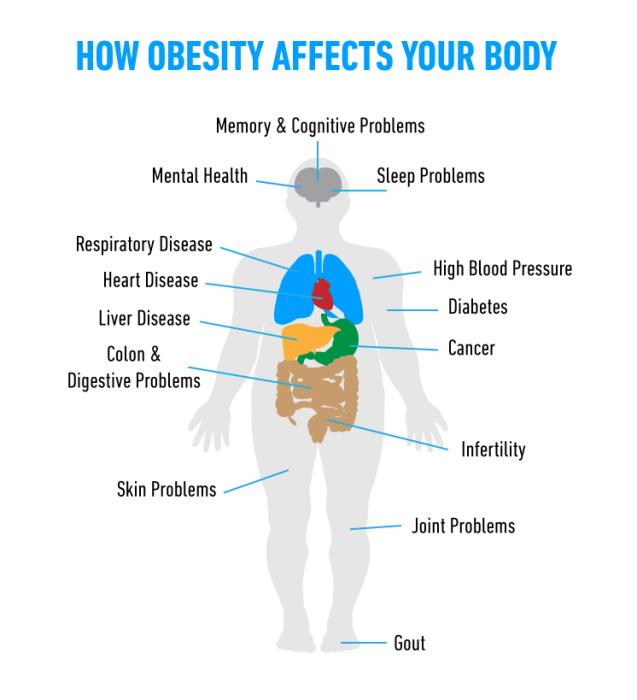Obesity is a complex health condition characterized by an excessive accumulation of body fat that poses a risk to overall health. It is typically measured using the body mass index (BMI), with a BMI of 30 or higher classified as obese. Obesity can result from a combination of genetic, environmental, and lifestyle factors, including poor diet, physical inactivity, and metabolic conditions. Understanding obesity is essential for addressing its prevalence and associated health risks, such as diabetes, heart disease, and certain cancers.
As a significant public health issue, obesity has garnered increased attention due to its rising rates globally. Effective prevention and treatment strategies are necessary to combat obesity and improve health outcomes.
The Impact of Obesity on Body Image and Health
Obesity can profoundly affect an individual’s body image and mental health. Many people with obesity experience negative self-perception, which can lead to feelings of shame, low self-esteem, and depression. Societal stigma surrounding obesity often exacerbates these issues, contributing to a cycle of emotional eating and further weight gain.
Physically, obesity increases the risk of numerous health conditions, including cardiovascular diseases, type 2 diabetes, and joint problems. Addressing both the psychological and physical aspects of obesity is crucial for promoting overall well-being and encouraging individuals to pursue healthier lifestyles.
How Obesity Affects the Abdomen and Skin
Obesity significantly impacts the abdomen, often resulting in an increased accumulation of fat around the abdominal area. This visceral fat can lead to a distended abdomen and may contribute to a range of health problems, including metabolic syndrome and an increased risk of chronic diseases. Furthermore, excess abdominal fat can create pressure on surrounding organs, leading to complications such as gastroesophageal reflux disease (GERD).

In terms of skin, obesity can lead to changes in skin elasticity and contribute to the development of conditions such as skin tags and intertrigo (a skin irritation in skin folds). These changes can affect comfort and quality of life, underscoring the importance of addressing obesity through comprehensive health strategies.
The Connection Between Obesity and Excess Skin
Excess skin often develops as a consequence of obesity, particularly after significant weight loss. When individuals lose a substantial amount of weight, the skin may not fully retract due to a loss of elasticity, leaving behind sagging or loose skin. This can occur in various areas, including the abdomen, thighs, and arms, and may lead to physical discomfort and hygiene issues.
Understanding the connection between obesity and excess skin is vital for individuals considering weight loss options, as surgical interventions such as body contouring procedures may be necessary to achieve a more desirable body shape after substantial weight loss.
Weight Loss and Its Effects on the Abdomen
Weight loss can have significant effects on the abdomen, often leading to improvements in overall health and body composition. As individuals lose weight, the reduction of visceral fat can decrease the risk of obesity-related diseases and improve metabolic health. However, weight loss may also result in changes to skin appearance, particularly if it occurs rapidly or if a person has experienced obesity for an extended period.

In some cases, individuals may be left with excess skin and laxity in the abdominal area, which can affect self-esteem and body image. Therefore, a comprehensive approach to weight loss that includes exercise, nutrition, and potential surgical options for skin removal may be necessary to achieve desired results and improve overall quality of life.
Diastasis Recti: A Common Condition in Obese Individuals
Diastasis recti is a condition characterized by the separation of the abdominal muscles, which can commonly occur in obese individuals due to increased pressure on the abdominal wall. The excess weight can lead to stretching and weakening of the muscles, making them more prone to separation, especially during pregnancy or significant weight fluctuations. Recognizing diastasis recti is crucial for those with obesity, as it can impact core strength, posture, and overall physical function. Early intervention through appropriate exercises or surgical options can help manage the condition effectively.
The Psychological Effects of Obesity on Body Confidence
Obesity can significantly impact an individual's body confidence and self-esteem. Many people struggle with negative body image due to societal pressures and personal perceptions of their appearance. This can lead to feelings of shame, anxiety, and social withdrawal. Additionally, physical limitations associated with obesity may contribute to further psychological distress, making it challenging for individuals to engage in social activities or maintain relationships. Addressing these psychological effects is an important aspect of comprehensive weight management and body contouring solutions.

When to Consider a Tummy Tuck After Weight Loss
Considering a tummy tuck after significant weight loss is often appropriate when individuals experience excess skin, stubborn fat deposits, or diastasis recti that do not improve with diet and exercise. It is generally recommended to wait until weight stabilization occurs, typically at least six months after reaching a healthy weight, to ensure optimal surgical outcomes. Consulting with a qualified surgeon can help determine the right timing for the procedure based on individual circumstances and goals.
The Role of a Tummy Tuck in Post-Obesity Body Contouring
A tummy tuck plays a vital role in post-obesity body contouring by addressing excess skin, fat, and muscle separation that often result from significant weight loss. The procedure not only removes surplus skin and fat but also tightens the abdominal muscles, enhancing the overall shape and appearance of the abdomen. This comprehensive approach can significantly boost self-esteem and body confidence, helping individuals enjoy their weight loss results more fully.

Surgical vs. Non-Surgical Options for Abdominal Concerns
When addressing abdominal concerns, individuals have both surgical and non-surgical options available. Surgical interventions, such as tummy tucks, offer significant results for those with excess skin and muscle separation. Non-surgical alternatives, including CoolSculpting and radiofrequency treatments, may provide moderate improvements for individuals with less severe issues or those who are not ready for surgery. A thorough evaluation by a healthcare professional can help determine the most suitable option based on individual needs and goals.
Understanding the Tummy Tuck Procedure for Obese Patients
The tummy tuck procedure for obese patients typically involves a comprehensive approach to address excess skin, fat, and muscle separation. The surgery begins with the surgeon making an incision, which can vary based on the extent of the procedure. Excess skin and fat are removed, and the abdominal muscles are tightened. The surgeon may also create a new belly button to ensure a natural appearance. Understanding the specific techniques used can help patients feel more informed and comfortable with their decision.
Recovery Expectations for Tummy Tuck Surgery
Recovery from tummy tuck surgery generally involves a period of rest and gradual return to daily activities. Patients can expect swelling, bruising, and discomfort during the initial recovery phase, which usually lasts two to four weeks. It is important to follow post-operative care instructions, including wearing compression garments and attending follow-up appointments. Most individuals can return to light activities within a few weeks, but strenuous exercise should be avoided for at least six to eight weeks to ensure proper healing.
The Importance of a Healthy Lifestyle Post-Surgery
Maintaining a healthy lifestyle after a tummy tuck is crucial for preserving the results of the procedure. A balanced diet and regular exercise can help prevent weight regain and support overall well-being. Patients are encouraged to incorporate core-strengthening exercises to enhance abdominal muscle tone and stability. Adopting healthy habits not only contributes to the longevity of surgical results but also promotes a positive mindset and improved quality of life.
Potential Risks and Complications for Obese Patients
Obese patients may face specific risks and complications associated with tummy tuck surgery, including higher rates of infection, delayed wound healing, and increased scarring. Other potential complications can include blood clots and issues related to anesthesia. It is essential for obese individuals to discuss these risks with their surgeon and ensure that they are adequately prepared for surgery. Proper pre-operative evaluations and adherence to post-operative care can help minimize complications.
Combining Tummy Tuck with Other Weight Loss Procedures
Combining a tummy tuck with other weight loss procedures, such as bariatric surgery or liposuction, can be an effective strategy for individuals seeking comprehensive body contouring. This approach allows for the simultaneous removal of excess skin and fat while addressing underlying weight-related issues. Working with a qualified team of healthcare professionals ensures that patients receive personalized care and optimal outcomes. Discussing individual goals and concerns with a surgeon can help determine the best combination of procedures for achieving desired results.
The Role of Nutrition in Preventing Excess Skin
Nutrition plays a critical role in preventing excess skin, especially after significant weight loss. A balanced diet rich in vitamins, minerals, and antioxidants helps maintain skin elasticity and overall health. Key nutrients, such as collagen, vitamin C, and omega-3 fatty acids, support skin structure and promote healing. Staying hydrated is also essential, as proper hydration helps maintain skin elasticity. By prioritizing a nutrient-dense diet before and after weight loss, individuals can optimize their skin's appearance and potentially reduce the severity of loose skin.
How to Prepare for a Tummy Tuck Consultation
Preparing for a tummy tuck consultation involves gathering relevant medical history and formulating questions for the surgeon. Patients should be ready to discuss their health status, weight history, and any previous surgeries. It’s also helpful to have realistic expectations about the procedure and its outcomes. Important questions to ask include the surgeon's experience, the specific techniques recommended, recovery timelines, and potential risks. Taking notes during the consultation can help in making informed decisions about the surgery.
Success Stories: Tummy Tuck Transformations After Obesity
Success stories of tummy tuck transformations after obesity often highlight dramatic improvements in both physical appearance and emotional well-being. Many patients report significant boosts in self-esteem and body confidence, allowing them to engage in activities they previously avoided. These testimonials frequently emphasize the transformation from excess skin and stubborn fat to a firmer, flatter abdomen. Such stories serve as inspiration for individuals considering the procedure, showcasing the potential for life-changing results after significant weight loss.
Addressing Emotional and Psychological Needs Post-Surgery
Addressing emotional and psychological needs post-surgery is essential for a successful recovery. Many individuals may experience a range of emotions, including joy, anxiety, and even sadness as they adjust to their new bodies. Support groups, counseling, or therapy can provide valuable assistance in navigating these feelings. Encouraging self-care practices and fostering a positive mindset can also aid in emotional healing. Acknowledging and addressing these psychological aspects can enhance the overall recovery experience and contribute to long-term satisfaction with surgical results.
Conclusion: Finding Confidence After Obesity
Finding confidence after obesity often involves a multifaceted approach that includes surgical interventions, such as tummy tucks, alongside lifestyle changes and emotional support. The journey to improved body image and self-esteem can be transformative, allowing individuals to embrace their new appearances and engage more fully in life. By combining physical and psychological care, individuals can achieve sustainable results and a renewed sense of confidence, fostering a healthier and more fulfilling lifestyle.
Understanding Non-Surgical Options for Tummy Tuck Surgery
Explore the wide array of non-surgical alternatives to traditional tummy tuck procedures that can help you achieve a toned and contoured abdomen without undergoing invasive surgery. These options include innovative techniques like laser treatments, ultrasound therapy, and fat-freezing procedures, which provide noticeable results with minimal recovery time.
Best Tummy Tuck Surgery in India
The Best Tummy Tuck Surgery in India offers patients a solution to achieve a flatter abdomen through advanced surgical techniques, improving body contour and enhancing confidence.
Best Tummy Tuck Hospitals in India
The Best Tummy Tuck Hospitals in India provide state-of-the-art facilities with skilled medical teams, ensuring comprehensive care that includes personalized pre-operative consultations and diligent post-operative support.
Tummy Tuck Surgery Cost in India
The Tummy Tuck Surgery Cost in India is designed to be accessible, offering competitive pricing while upholding high standards of safety and care at renowned hospitals.
Best Tummy Tuck Surgeons in India
The Best Tummy Tuck Surgeons in India are highly trained professionals specializing in body contouring, employing precise techniques to deliver optimal results tailored to individual patient needs.
FAQ
Can a tummy tuck help with loose skin after significant weight loss?
Yes, a tummy tuck is specifically designed to address loose skin and excess fat in the abdominal area following significant weight loss. The procedure removes surplus skin and tightens the underlying muscles, resulting in a flatter and firmer abdomen.
What are the requirements for being a candidate for tummy tuck surgery?
Candidates for tummy tuck surgery should be in good overall health, have realistic expectations, and be at or near their target weight. Individuals with significant excess skin, stubborn fat, or diastasis recti are typically ideal candidates. A thorough evaluation by a qualified surgeon is essential to determine eligibility.
How can I maintain my weight after a tummy tuck?
Maintaining weight after a tummy tuck involves adopting a healthy lifestyle that includes a balanced diet and regular exercise. It’s important to establish a routine that promotes long-term healthy habits to prevent weight regain. Staying committed to these lifestyle changes can help sustain the results of the surgery.
Are there any specific risks for obese individuals undergoing surgery?
Obese individuals may face increased risks when undergoing tummy tuck surgery, including a higher likelihood of complications such as infection, delayed wound healing, and blood clots. It’s crucial for these patients to discuss their specific risks with their surgeon and ensure they are adequately prepared for the procedure.
What lifestyle changes should I consider before a tummy tuck?
Before a tummy tuck, individuals should consider adopting a healthier lifestyle that includes a balanced diet, regular physical activity, and weight management. Quitting smoking and reducing alcohol intake can also improve surgical outcomes and facilitate better healing. Discussing these changes with a healthcare professional can provide additional guidance.